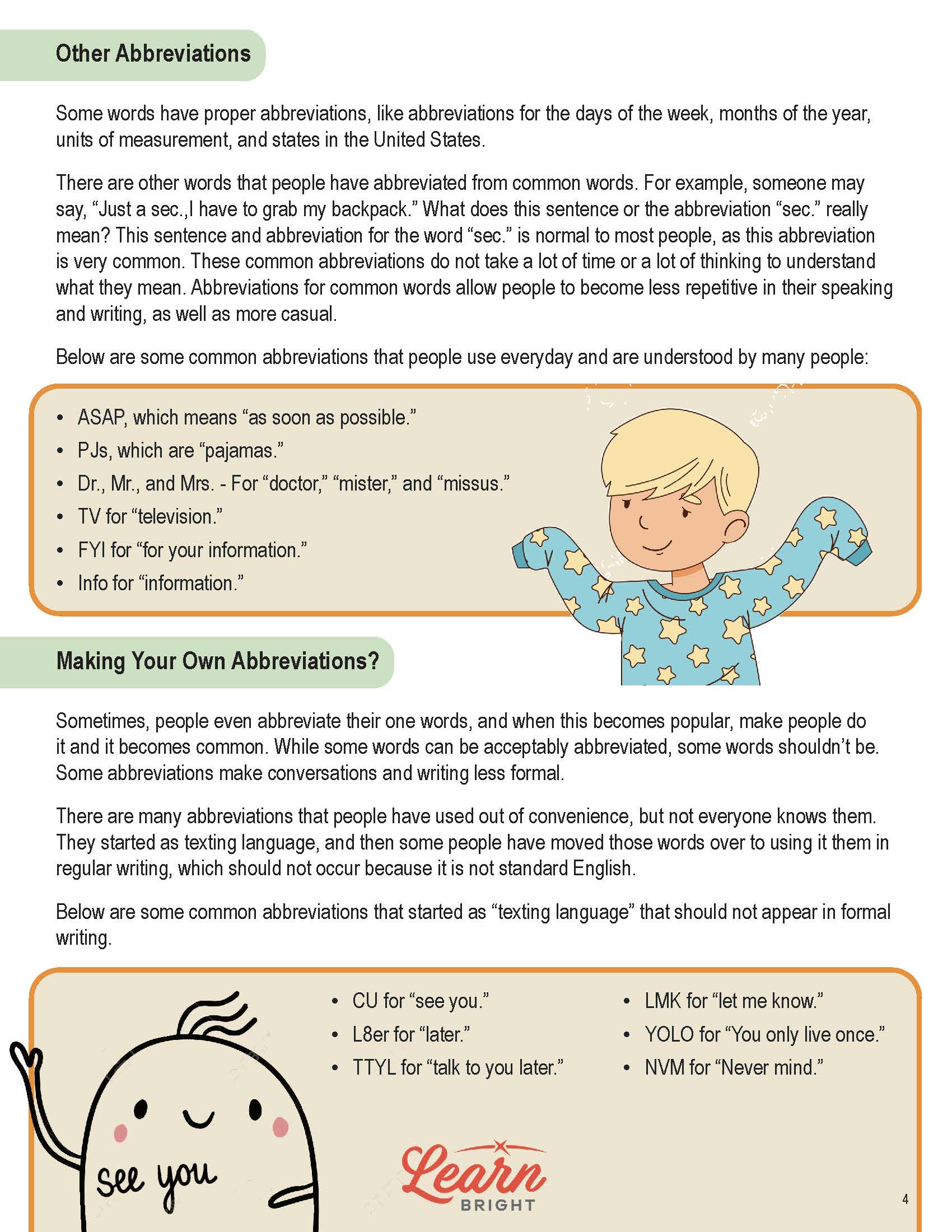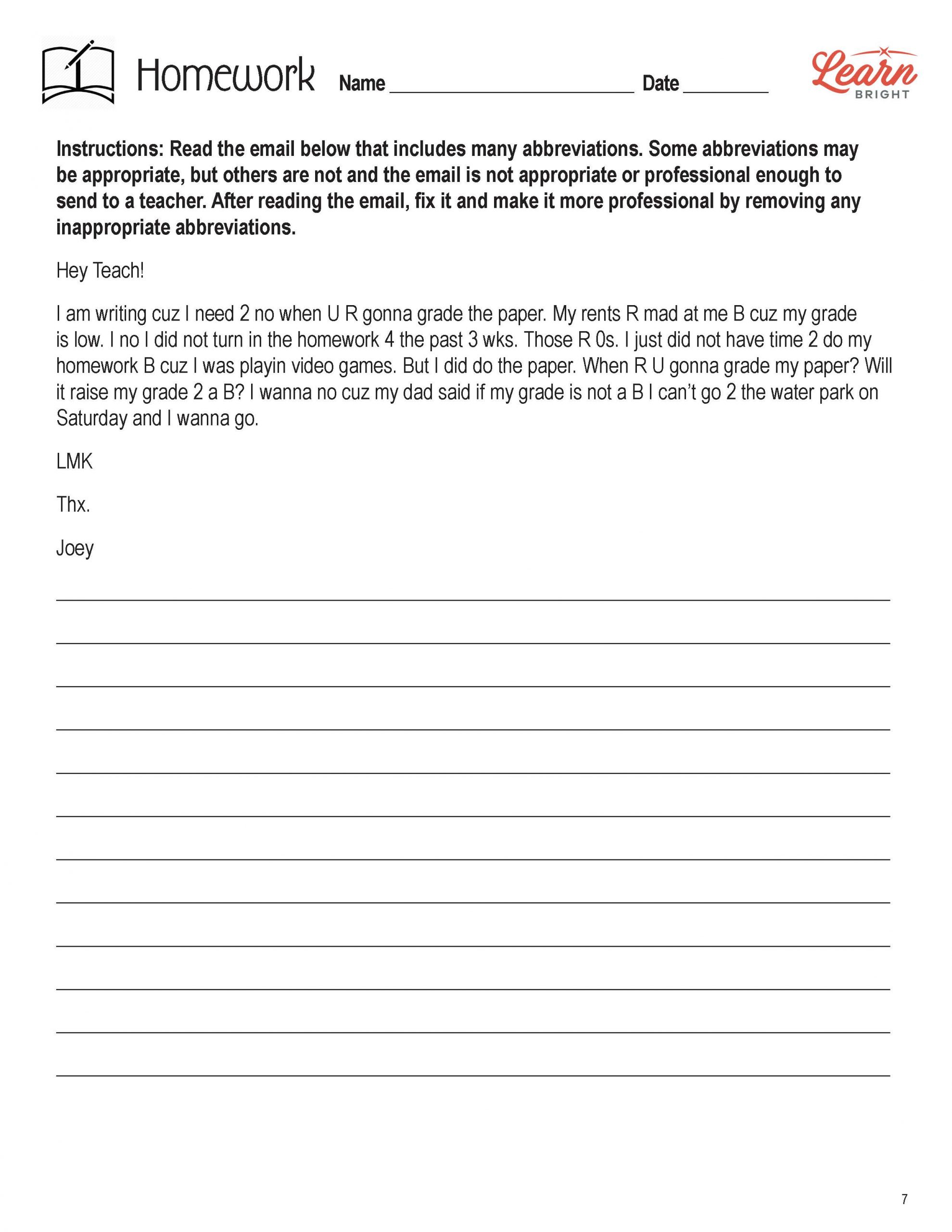Description
What our Abbreviations – Grades 3-4 lesson plan includes
Lesson Objectives and Overview: Abbreviations – Grades 3-4 introduces students to common abbreviations and why they are used. They will learn about appropriate and inappropriate abbreviations and when to abbreviate words. At the end of this lesson, students will understand that abbreviations are used to shorten certain words like names of states, measurements, and months of the year. This lesson is for students in 3rd grade and 4th grade.
Classroom Procedure
Every lesson plan provides you with a classroom procedure page that outlines a step-by-step guide to follow. You do not have to follow the guide exactly. The guide helps you organize the lesson and details when to hand out worksheets. It also lists information in the green box that you might find useful. You will find the lesson objectives, state standards, and number of class sessions the lesson should take to complete in this area. In addition, it describes the supplies you will need as well as what and how you need to prepare beforehand. The supplies you will need for this lesson are pencils, pens, highlighters, and internet access.
Options for Lesson
Included with this lesson is an “Options for Lesson” section that lists a number of suggestions for activities to add to the lesson or substitutions for the ones already in the lesson. The only suggested addition to this lesson is to use the website included in this section to find additional resources for your students, like games and worksheets.
Teacher Notes
The teacher notes page includes a paragraph with additional guidelines and things to think about as you begin to plan your lesson. This page also includes lines that you can use to add your own notes as you’re preparing for this lesson.
ABBREVIATIONS – GRADES 3-4 LESSON PLAN CONTENT PAGES
Abbreviations
The Abbreviations – Grades 3-4 lesson plan includes two content pages. Abbreviations are the shortened form of words. You might use abbreviations in your daily conversations or in your writing.
Common Abbreviations
We have a few rules for abbreviating words. People have already established some abbreviations and we use them in common writing. Many of these fall into a few main categories. For example, we abbreviate days of the week (Mon. for Monday, Wed. for Wednesday), measurements (lbs. for pounds, ft. for feet), months of the year (Jan. for January, Aug. for August), and states in the United States (IN for Indiana, TX for Texas).
Other Abbreviations
While some words have proper abbreviations, like the ones discussed earlier in the lesson, some common words have abbreviations as well. For example, someone might say “Just a sec!” In this example, sec is a common abbreviation for the word second. These kinds of abbreviations are easy to understand because they’re so common in our everyday speaking. Using these abbreviations allow people to be less repetitive in their speaking and to be more casual.
Some other common abbreviations that we use often are: ASAP (as soon as possible), PJs (pajamas), Dr., Mr., and Mrs. (Doctor, Mister, and Missus), TV (television), FYI (for your information), and info (information).
Making Your Own Abbreviations?
People sometimes create their own abbreviations. However, you should not abbreviate all words in all situations. Some abbreviations can make your conversations and writing less formal.
Some people use abbreviations for convenience, but not everyone will know what they mean. We know some of these as texting language. You should not use them in your regular writing, because they aren’t standard English.
Some of these include CU (see you), LMK (let me know), L8er (later), YOLO (you only live once), TTYL (talk to you later), and NVM (never mind).
ABBREVIATIONS – GRADES 3-4 LESSON PLAN WORKSHEETS
The Abbreviations – Grades 3-4 lesson plan includes three worksheets: an activity worksheet, a practice worksheet, and a homework assignment. You can refer to the guide on the classroom procedure page to determine when to hand out each worksheet.
SENTENCES ACTIVITY WORKSHEET
For the activity worksheet, students will listen to their teacher read two sets of sentences out loud. For the first set, they will choose which words are abbreviated and write them down. And for the second set, they will choose which words could be abbreviated but are not currently, and will write those down along with their abbreviation. They will share their answers with the class.
REWRITING PRACTICE WORKSHEET
The practice worksheet asks students to read ten sentences and abbreviate the words for days of the week, months of the year, measurements, and states.
ABBREVIATIONS – GRADES 3-4 HOMEWORK ASSIGNMENT
For the homework assignment, students will read the email printed on the worksheet and rewrite it to take out any inappropriate abbreviations.
Worksheet Answer Keys
This lesson plan includes answer keys for the practice worksheet and the homework assignment. If you choose to administer the lesson pages to your students via PDF, you will need to save a new file that omits these pages. Otherwise, you can simply print out the applicable pages and keep these as reference for yourself when grading assignments.









